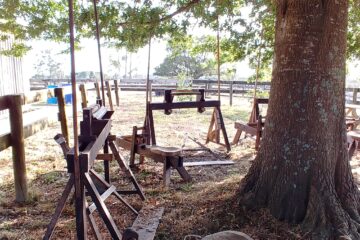
So this is all happening because of a chance bit of searching on the basis of finding something old, namely, some boots I had made years ago.
These were made by Sue Engels of Something Shoetable, which at the time was based in Upper Cuba street, Wellington.
There were various building around upper Cuba street that were on the proposed route of the motorway that were technically owned by the Ministry of Transport (or maybe Transit New Zealand- not sure which). The tenants were on something like a month long lease, that meant that should the motorway get the go ahead the the buildings could be emptied quickly to allow work to start. Because of the short term leases, and the failure to invest in the buildings and maintain them at all, the rents on many of these buildings were ridiculously cheap considering the location and closeness to town. As a result the shop fronts and the buildings were within reach of small businesses, and craft and arts of various sorts. Also some slightly dodgy living arrangements in “warehouse” space as well.
Anyway, the boots made by Sue Engels have stayed with me, even if not in a great form currently. Not always worn, they have spent a lot of time in storage. So finding them, and thinking about engaging in more crafts after the recent knife making, set me to thinking about what became of Sue Engels.
A web search revealed that she was now based on Waiheke Island, and moreover, she was teaching elements of shoemaking.
Excellent.
Day One.
So after making my way north to Auckland, and securing a spare bed from a friend of my partner on Waiheke, I made my way to Sue’s studio; a small shed out the back, and began my lessons.
At the end of the first day, we had spent much of the day pattern making. This is all about taking a three dimensional form, the last, and creating patterns for 2 dimensional shapes, that will then be cut out, and made back into 3 dimensional shapes. The last is the form of a shoe, and in high end shoe manufacture, you might have a last made for you, which the shoemaker can then use for all future shoes they make for you. A last is sort of a model of your foot. I say sort of, because its rather stylised, and might be best thought of as the ideal shape that your foot would be, if it had certain measurements, and was designed to live in a shoe. Lasts were traditionally made from wood, although the last I was going to use was plastic. They have to have leather stretched over them, take nails to hold the leather at certain points, and modern lasts can “break” in the middle to allow the last to be removed from the shoe. They also have a robust hole for a peg to slot into for working on a bench.
Pattern making itself is suitably tricky. The various shapes, and parts, have to overlap in the right kind of way to work. Some of the terms to describe these parts, or parts of these parts, make sense. The seat is where the base of the heel sits in the shoe. But the “vamp” is the interesting bit. Thats the front piece. It goes over the nose of the last, so over your toes. Its a key piece of structure, and the bit that gets most seen.
They way that these part fit together is partly dependent on the style of shoe you want to make. So an ‘Oxford’ is a distinctive style of shoe because of the “cut;” a certain part, the quarter say, sits over the vamp, rather than under it. So parts, and they way they fit together and are assembles helps determine the shape, and also the look of a shoe. So wing tip shoes have a certain shaped bit out the front of the shoe, Oxfords have a different configuration, and so on.
Not only do these parts need to fit together, they also will overlap in certain ways, and allow for decorative edges or trims.
I had some tricky decisions to make. I chose some very heavy leather, that was also very textured with a great deal of character. But that means that things like having a brogue, the small patterned bit of hole punching along an edge, become a bit over the top. But, I kind of wanted that “luxury” feel that come with a the brogue.
In the end, I think that hand made element, and that luxury, might come with the stitching. That should, I think, convey that attention to small details necessary.


